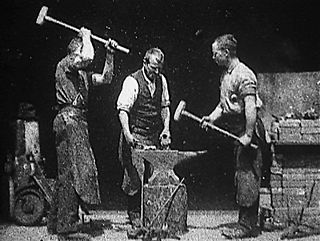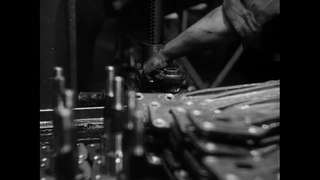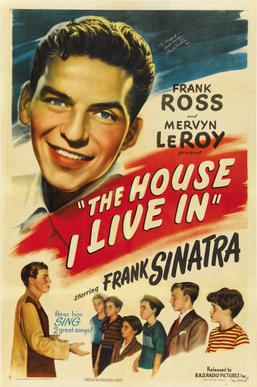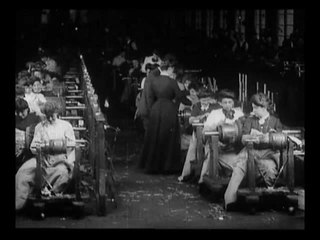Related Research Articles

Blacksmith Scene is an 1893 American short black-and-white silent film directed by William K.L. Dickson, the Scottish-French inventor who, while under the employ of Thomas Edison, developed one of the first fully functional motion picture cameras. It is historically significant as the first Kinetoscope film shown in public exhibition on May 9, 1893, and is the earliest known example of actors performing a role in a film. 102 years later, in 1995, Blacksmithing Scene was selected for preservation in the United States National Film Registry by the Library of Congress as being "culturally, historically, or aesthetically significant". It is the second-oldest film included in the Registry, after Newark Athlete (1891).
Czechoslovakia 1968 is a 1969 short documentary film about the "Prague Spring", the Warsaw Pact invasion of Czechoslovakia. The film was produced by the United States Information Agency (USIA) under the direction of Robert M. Fresco and Denis Sanders and features the graphic design of Norman Gollin.

Jam Session is a 1942 short film, directed by Josef Berne, which shows Duke Ellington and his orchestra performing "C Jam Blues".

The Living Desert is a 1953 American nature documentary film that shows the everyday lives of the animals of the desert of the Southwestern United States. The film was written by James Algar, Winston Hibler, Jack Moffitt (uncredited) and Ted Sears. It was directed by Algar, with Hibler as the narrator and was filmed in Tucson, Arizona. The film won the 1953 Oscar for Best Documentary.

Master Hands is a 1936 sponsored documentary film short which shows what work is like in a Chevrolet automobile factory. It was produced by the Jam Handy Organization, a pioneer in industrial film production.
Tulips Shall Grow is a 1942 American animated short film in the Puppetoons series, directed by George Pal and starring Rex Ingram and Victor Jory. It was released by Paramount Pictures and originally photographed in 3-strip Technicolor. It later became the black-and-white edition by National Telefilm Associates.

The House I Live In is a ten-minute short film written by Albert Maltz, produced by Frank Ross and Mervyn LeRoy, and starring Frank Sinatra. Made to oppose anti-Semitism at the end of World War II, it received an Honorary Academy Award and a special Golden Globe Award in 1946.

Princess Nicotine; or, The Smoke Fairy is a 1909 five-minute silent film directed by J. Stuart Blackton.

Westinghouse Works, 1904 is a collection of American short silent films, each averaging about three minutes in length. The films were taken from April 18, 1904, to May 16, 1904, in Pittsburgh, Pennsylvania, and document various Westinghouse manufacturing plants. They were made by G. W. "Billy" Bitzer of the American Mutoscope and Biograph Company, were shown at the Westinghouse Auditorium at the 1904 St. Louis World's Fair, and may have been made for that purpose. At least 29 films were produced and 21 remain in the collection which is now a part of the National Film Registry of the Library of Congress.

Duck and Cover is a 1952 American civil defense animated live-action social guidance film that is often mischaracterized as propaganda. It has similar themes to the more adult-oriented civil defense training films. It was widely distributed to United States schoolchildren in the 1950s, and teaches students what to do in the event of a nuclear explosion.
The Prelinger Archives is a collection of films relating to U.S. cultural history, the evolution of the American landscape, everyday life, and social history. It was in New York City from 1982 to 2002 and is now in San Francisco.

Rick Prelinger is an American archivist, writer, and filmmaker. A professor at the University of California, Santa Cruz, Prelinger is best known as the founder of the Prelinger Archives, a collection of 60,000 advertising, educational, industrial, and amateur films acquired by the Library of Congress in 2002 after 20 years' operation.

Lady Helen's Escapade is a short American comedy film produced in 1909, directed by D. W. Griffith. It is about the escapades of Lady Helen working as a domestic in a boarding house.

The Evidence of the Film is a 1913 American silent short crime film directed by Lawrence Marston and Edwin Thanhouser, starring William Garwood.
Sponsored film, or ephemeral film, as defined by film archivist Rick Prelinger, is a film made by a particular sponsor for a specific purpose other than as a work of art: the films were designed to serve a specific pragmatic purpose for a limited time. Many of the films are also orphan works since they lack copyright owners or active custodians to guarantee their long-term preservation.
An orphan film is a motion picture work that has been abandoned by its owner or copyright holder. The term can also sometimes refer to any film that has suffered neglect.

St. Louis Blues is a 1929 American two-reel short film starring Bessie Smith. The early sound film features Smith in an African-American speakeasy of the prohibition era singing the W. C. Handy standard, "St. Louis Blues". Directed by Dudley Murphy, it is the only known film of Bessie Smith, and the soundtrack is her only recording not controlled by Columbia Records.
Disneyland Dream (1956) is a home movie made by Robbins and Meg Barstow that documents their family's free trip to the newly opened Disneyland. The one-week trip was a prize they won in a contest sponsored by Scotch tape. The movie was shot with a 16 mm handheld camera. It lasts approximately 35 minutes. An audio track was added to the film in 1995.

Last Clear Chance is a 1959 American short film produced and directed by Robert Carlisle.
Panorama Ephemera is a 2004 collage film by film archivist Rick Prelinger.
References
- ↑ "About ACA". American Coatings Association.
- ↑ Zimring, Carl A.; Editor, William L. Rathje, Consulting (Feb 27, 2012). Encyclopedia of Consumption and Waste: Encyc Consumption and Waste. SAGE Publications. ISBN 9781506338279 – via Google Books.
{{cite book}}:|last2=has generic name (help)CS1 maint: multiple names: authors list (link) - ↑ "American Paint and Oil Dealer ..." American Paint Journal Company, Incorporated. Aug 7, 1917 – via Google Books.
- ↑ "Preservation News 1 March 1965 — Preservation News". prn.library.cornell.edu.
- ↑ Mike Mashon (March 10, 2015). "The Cold War Meets Commerce: The House(s) in the Middle". Now See Hear!. Library of Congress. Retrieved August 6, 2015.
- ↑ "Past to Present". American Coatings Association. Retrieved August 6, 2015.
- ↑ Eden, Lynn. "Whole World on Fire: Organizations, Knowledge & Nuclear Weapons Devastation" . Retrieved 9 June 2017.
- ↑ "Complete National Film Registry Listing". Library of Congress. Retrieved 2020-04-30.
- ↑ "Librarian of Congress Names 25 More Films to National Film Registry". Library of Congress. Retrieved 2020-04-30.
- ↑ Panorama Ephemera (2004) - Rick Prelinger on YouTube